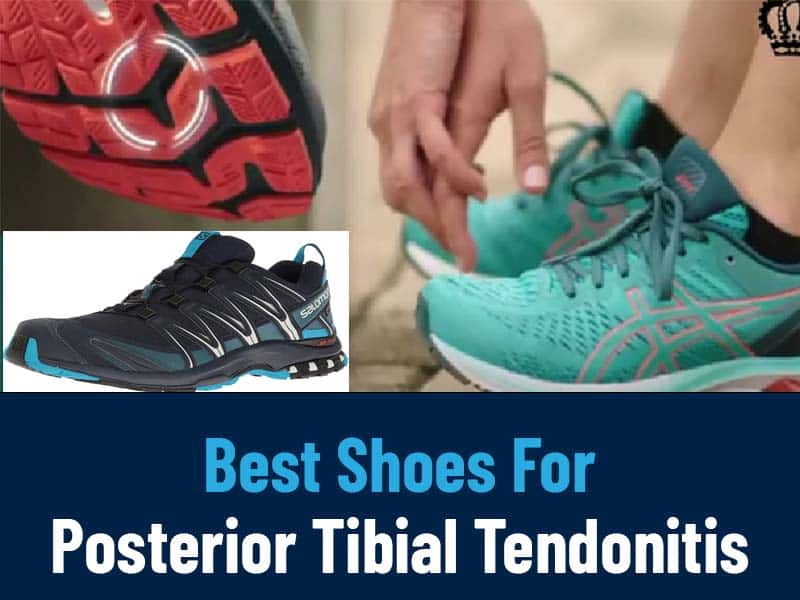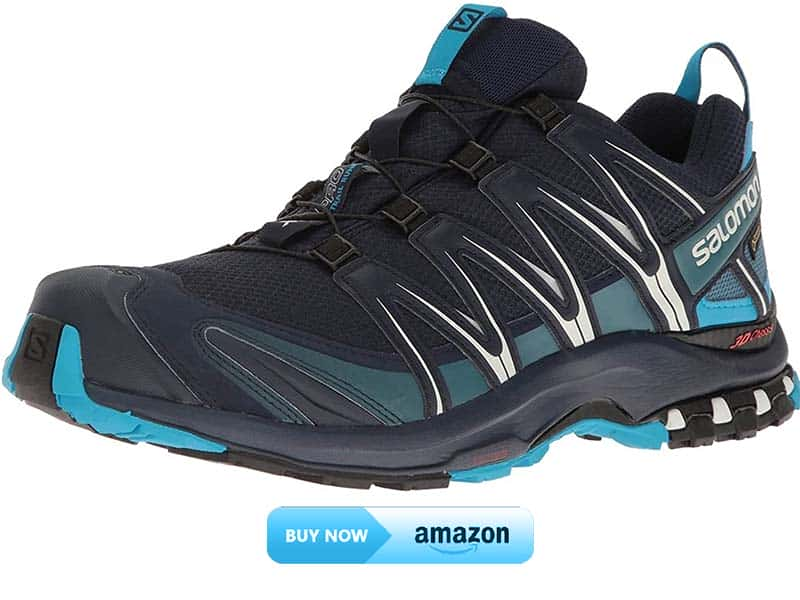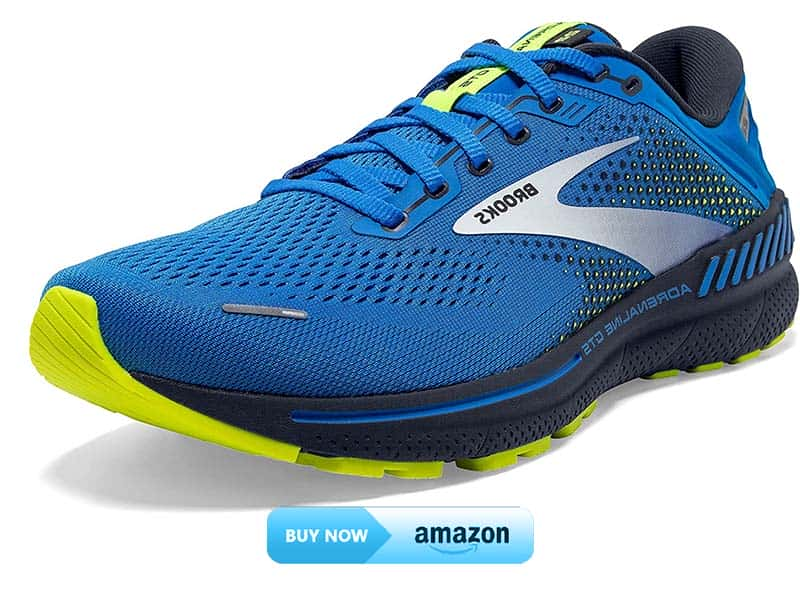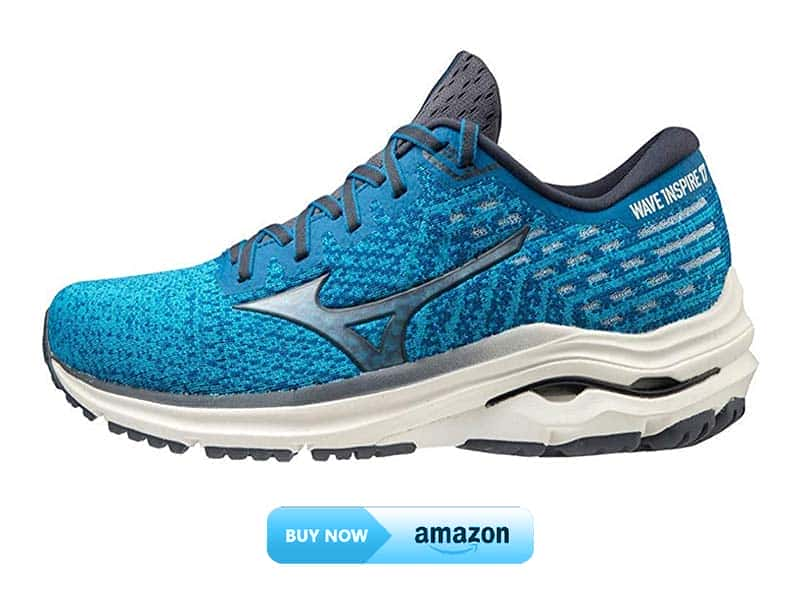Posterior tibial tendonitis can be a painful and frustrating condition to deal with, especially when it comes to finding the right shoes.
However, there are options available that can provide the support and stability necessary to alleviate discomfort and prevent further injury.
Here, I’ll look at the three best shoes for posterior tibial tendonitis. But Salomon Men’s XA PRO 3D Gore-TEX Trail Running Shoes are my first choice.
Yet, with their advanced design and exceptional support, these shoes are an excellent choice for anyone with this condition.
I’ll also explore the unique features that make each of these shoes stand out, helping you make the best choice for your individual needs.
Contents
Understanding Posterior Tibial Tendonitis
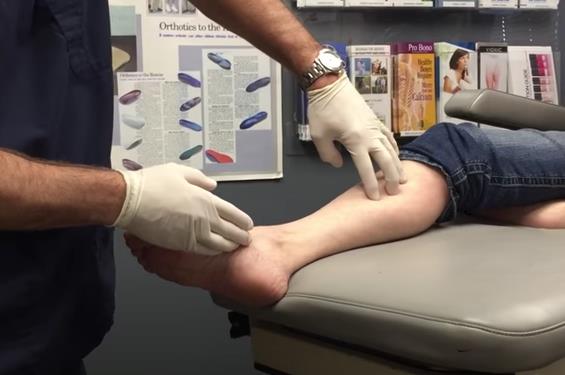
Posterior tibial tendonitis, also known as pttd, is a condition that occurs when the posterior tibial tendon that connects the calf muscles to the inside of the foot becomes inflamed or torn. This tendon is one of the most important tendons in the lower leg, and it helps to support the arch of the foot and aids in walking.
When it is damaged, it can cause much pain and discomfort, and in severe cases, it can even lead to the collapse of the foot’s arch.
What Is Posterior Tibial Tendonitis?
Posterior tibial tendonitis is a condition that occurs when the posterior tibial tendon is injured or inflamed. Here are some key points to understand about the condition:
- Pttd is caused by overuse of the posterior tibial tendon, which can lead to small tears and inflammation.
- It is commonly seen in athletes such as runners or basketball players who engage in repetitive activities that involve the foot.
- Wearing shoes that do not provide adequate arch support can also cause pttd.
Symptoms Of Posterior Tibial Tendonitis
Pttd can cause a variety of symptoms, including:
- Pain and swelling on the inside of the foot
- Pain that worsens with physical activity
- Aching or discomfort along the ankle, calf, or knee
- Difficulty walking or standing for long periods of time
- Fallen arches or a flatfoot appearance
It is essential to seek medical attention if these symptoms occur, as early treatment can prevent the condition from worsening.
Diagnosis Of Posterior Tibial Tendonitis
To diagnose pttd, a healthcare professional will typically perform a physical exam, which may include observing the patient standing or walking. They may also use imaging tests such as x-rays or an mri to inspect the tendon for tears or other damage.
Understanding the causes and symptoms of pttd is critical to prevent the condition from worsening. Seeking prompt medical attention and taking preventive measures such as wearing shoes with adequate arch support can help to manage the condition effectively.
Factors To Consider When Choosing Shoes For Posterior Tibial Tendonitis
Say Goodbye To Pain: Best Shoes For Posterior Tibial Tendonitis
Posterior tibial tendonitis is a condition where the posterior tibial tendon becomes inflamed or damaged, leading to pain. Sometimes, the best remedy to alleviate the burden the condition causes is to choose the right pair of shoes. But with so many options available on the market, selecting the right one can seem like a daunting task.
Here, we’ll walk you through the factors to consider when choosing the best shoes for posterior tibial tendonitis.
Importance Of Selecting The Right Shoes
Selecting the right shoes is crucial because it helps alleviate pain and prevent further injury. Shoes that are designed for people with posterior tibial tendonitis are manufactured to offer support, stability, and cushioning, all of which are vital in reducing pressure on the affected foot.
How To Choose The Right Shoes
Choosing the right shoes for posterior tibial tendonitis can be crucial in managing the condition effectively. Consider the following factors when selecting shoes:
Factors To Consider When Selecting Shoes
Arch Support:
Shoes providing excellent arch support, distribute the pressure of the foot evenly. It helps in protecting the posterior tibial tendon from further strain, which alleviates pain.
Shock Absorption:
Adequate shock absorption reduces the impact on the foot from regular activities such as walking or running. This reduces pressure on the posterior tibial tendon, reducing inflammation and alleviating pain.
Stability:
The best shoes for posterior tibial tendonitis provide excellent stability. Shoes with a wide base are ideal as they offer an excellent surface area for the foot to rest on, making it more stable.
Flexibility:
Shoes that are too stiff or too loose are not suitable for people with posterior tibial tendonitis. The ideal shoe will be both flexible and firm enough to provide support where required.
Selecting the best shoes for posterior tibial tendonitis can be the difference between pain and comfort. Always consider arch support, shock absorption, stability, and flexibility when purchasing a new pair of shoes. By choosing suitable shoes for your condition, you will reduce inflammation, alleviate pain, and provide support, enabling you to move more freely.
Best Shoes For Posterior Tibial Tendonitis
Today I am here to discuss the top rated 3 best shoes for Posterior Tibial Tendonitis. These 3 shoes are:
- Salomon XA PRO 3D Gore Shoes- Best for overall
- Brooks Men’s Adrenaline Supportive Running Shoe- Best For Overpronation
- Mizuno Men’s Wave Inspire 16 Running Shoe Road- Best For Lightweight
Salomon XA PRO 3D Gore Shoes
Trail Running Shoes with Waterproof, Durable, Supportive, Cushioned, and Versatile Features, perfect for Outdoor Enthusiasts.
The Salomon Men’s XA PRO 3D Gore Shoes are a great example of the brand’s history of innovative design and love for mountain sports. These shoes are imported and made to last with a mix of 50% synthetic and 50% textile materials.
The full Gore-Tex bootie on the Salomon Men’s XA PRO 3D Gore-TEX Trail Running Shoes is one of their best features. It protects the foot from the weather like nothing else. Whether running in the rain or hiking through the snow, these shoes keep your feet dry and comfortable.
The Shoes protect your feet from the weather and have a 3D chassis that stabilizes your foot without limiting your forefoot mobility. You can keep moving quickly and nimbly on the trail while feeling safe and stable.
The Sensifit technology with quick laces ensures a precise fit, so you can enjoy a fast, comfortable fit for every foot. The shoes also have a high-traction Contagrip outsole, which gives a good grip on various surfaces, and a high-abrasion Contagrip outsole, making them more durable.
Overall, the Salomon Men’s XA PRO 3D Gore-TEX Trail Running Shoes are an excellent choice for anyone who loves trail running or hiking. Their advanced chassis, precise fit, and superior weather protection make them a reliable and comfortable option for all weather conditions.
Plus, Salomon is dedicated to new designs and loves mountain sports, so you know you’re getting a high-quality product from a reliable brand.
Pros:
- Full Gore-Tex bootie to protect against the weather
- The 3D chassis gives it stability without giving up mobility.
- Sensifit with quick lace makes sure the shoes fit perfectly.
- High-traction Contagrip outsole for excellent grip on various surfaces
- High-abrasion Contagrip to make it last longer
Cons:
Some types of feet may need to size up because the shoes may run small.
Brooks Men’s Adrenaline Supportive Running Shoe
comfortable, breathable, durable running shoes, GuideRails technology, DNA LOFT cushioning, versatile running shoes, everyday running shoes.
If you have posterior tibial tendonitis, finding shoes that give you enough support and comfort is essential. The Brooks Men’s Adrenaline GTS 22 Supportive Running Shoe is a top choice for people with this condition. These shoes are popular among runners because they have the proper support and comfort.
The Adrenaline GTS 22 is made in the USA or brought in from other countries. It has a rubber sole that works well on a variety of surfaces. They are great for everyday runs and help people with posterior tibial tendonitis land softly.
The Brooks GuideRails technology in these shoes gives them cushioning. This technology also keeps your feet in the right place while you run. This feature is beneficial if you have posterior tibial tendonitis because it helps to spread the pressure on your feet.
The Adrenaline GTS 22 has been updated to make the midsole of 100% DNA LOFT cushioning. This gives you a soft, smooth ride that is easy on your feet. The soft midsole and Segmented Crash Pad work together to make the transition from landing to toe-off easier, which makes your feet less tired.
Overall, if you have posterior tibial tendonitis, the Brooks Men’s Adrenaline GTS 22 Supportive Running Shoe is a great choice. They’re easy to wear, give good support, and are great for everyday runs.
The Brooks GuideRails technology keeps your feet in the right place, and the Segmented Crash Pad and soft midsole make the ride more comfortable.
Pros:
- It provides a good balance of support and softness
- Brooks GuideRails technology helps to keep feet in alignment
- 100% DNA LOFT cushioning offers a comfortable ride
- Suitable for everyday runs and soft landings
- Available in both made-in-the-USA or imported versions
Cons:
- Not ideal for trail running or rough terrain
- Sizing may run slightly small
Mizuno Men’s Wave Inspire 16 Running Shoe Road
Durable and comfortable running shoe with Mizuno Wave Technology for optimal stability and cushioning.
The Mizuno Men’s Wave Inspire 16 Running Shoe Road is a great choice for people with posterior tibial tendonitis. This shoe has the right cushioning and stability, so running in it will be comfortable and safe. The Wave Inspire 16 is a good shoe for daily runs and longer distances.
The shoe can be made in the U.S. or brought in from another country, giving people who prefer American-made goods a choice.
The rubber sole and X10 outsole make them very durable, so runners should buy them. The WAVEKNIT technology makes the shoe fit better and more securely, making it more comfortable to wear.
The Mizuno Enerzy Foam technology is more responsive and springy than traditional EVA technologies. This makes it a great choice for people with posterior tibial tendonitis.
The U4ic midsole has the best shock absorption, durability, and ride quality. The Fan Wave Plate technology makes the ride fast and stable, making each step smooth and easy.
Pros:
- Offers the right amount of cushioning and support.
- Made in the USA or brought in from other countries.
- Rubber sole and X10 outsole provide excellent durability
- WAVEKNIT technology makes the fit better overall.
- Mizuno Enerzy, Traditional EVA technology, is less responsive or springy than foam technology.
- The U4ic midsole provides the best shock absorption, durability, and ride.
- Fan Wave Plate technology makes the ride fast and stable.
Cons:
- Some may find the Wave Inspire 16 heavier than other running shoes.
- The price may be higher than other options on the market.
Comparison Table
Now I am sharing a comparison table for these three Amazon products so you can easily find the right one for your need.
| Feature | Salomon XA PRO 3D Gore-Tex Trail Running Shoe | Brooks Men’s Adrenaline GTS 22 Supportive Running Shoe | Mizuno Men’s Wave Inspire 16 Running Shoe Road |
|---|---|---|---|
| Made in | USA or Imported | USA or Imported | USA or Imported |
| Sole material | Rubber | Rubber | Rubber |
| Shaft height | Low top | Low top | Low top |
| Upper material | Textile and synthetic | Synthetic | Textile and synthetic |
| Cushioning technology | 3D Advanced Chassis and EVA foam | DNA LOFT midsole and Segmented Crash Pad | U4ic midsole and Fan Wave Plate technology |
| Support technology | Sensifit and OrthoLite sockliner | Brooks GuideRails technology | Wave knit technology and internal toe cap |
| Outsole material | Contagrip rubber | Rubber | Carbon rubber (X10) |
| Waterproof | Gore-Tex | Not specified | Not specified |
Tips For Properly Fitting Shoes For Posterior Tibial Tendonitis
Say Goodbye To Pain: Best Shoes For Posterior Tibial Tendonitis
Does your foot hurt when you walk, stand, or run? You may be experiencing posterior tibial tendonitis, a condition where the tendon that connects your calf muscle to your foot’s bones becomes inflamed or torn. Appropriate shoes can alleviate the pain and discomfort of this condition.
We’ll discuss the significance of appropriately fitting shoes, how to determine the appropriate size, the significance of trying on shoes, and wearing appropriate socks. Here are some tips to assist you in selecting the best shoes for posterior tibial tendonitis.
Importance Of Proper Shoe Fit
Wearing the proper shoes for your feet is crucial, particularly if you have posterior tibial tendonitis. The proper shoe fit offers the following advantages:
- Provides arch support and foot stability
- Reduces the probability of injury
- Promotes the proper alignment of the feet and lower legs
How To Determine Proper Shoe Size
The appropriate shoe size plays a crucial role in preventing and managing posterior tibial tendonitis. Here are some basic steps to assist you in determining the right shoe size:
- Measure your feet: Measure both of your feet, as one may be larger than the other. Your shoe size should be the larger of the two.
- Choose shoes with a broad toe box: Ensure that your toes have enough space to wiggle and move around comfortably.
- Determine the appropriate width: The width of the shoe is just as important as its length. Make sure you have enough space in the midfoot and heel areas.
Importance Of Trying On Shoes
When purchasing shoes for posterior tibial tendonitis, it’s critical to try them on before purchasing them. Here are some advantages of trying on shoes:
- Assists you in determining if the shoe fits snugly
- Helps you determine if the shoe provides enough support
- Enables you to test the outsole and midsole for shock absorption and stability.
Importance Of Wearing Appropriate Socks
What you wear on your feet is just as important as the shoes themselves. Wearing the proper socks is essential in preventing and managing posterior tibial tendonitis. Here are some tips to consider when it comes to socks:
- Select socks that wick moisture away from the skin and keep your feet dry.
- The right socks should be soft, with no seams that can irritate or rub against your feet.
- Compression socks may also assist in reducing foot discomfort and swelling.
Selecting the best shoes for posterior tibial tendonitis is crucial in preventing and managing foot discomfort. Following these basic guidelines for properly fitting shoes, selecting the appropriate size, trying them on, and wearing the right socks can assist you in finding the right shoes that work best for your condition.
Can Shoes Cause Posterior Tibial Tendonitis?
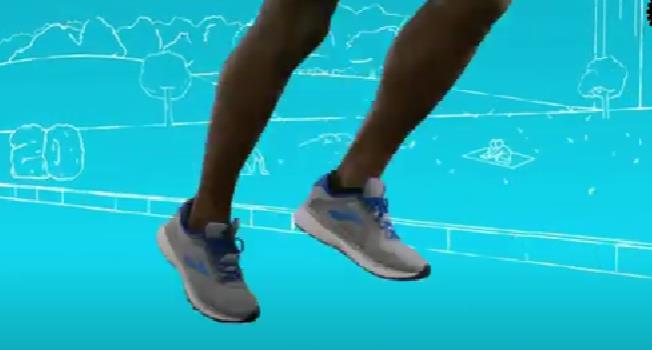
Yes, shoes can make it more likely for posterior tibial tendonitis to happen. When the posterior tibial tendon, which runs along the inside of the ankle and helps support the foot arch, is overused or strained, this problem happens.
When you wear shoes that don’t provide enough support, like high heels or shoes with a worn-out or uneven sole, the posterior tibial tendon can be put under too much stress, leading to inflammation and injury.
Posterior tibial tendonitis can also be caused by shoes that don’t fit right or don’t have enough support for the arch.
To avoid this condition, it’s essential to wear shoes that fit well and give your feet the support they need. This could mean choosing shoes with a supportive arch and heel and avoiding high heels and shoes with worn-out soles.
Stretching and strengthening exercises for the feet and ankles can also help prevent injuries and improve the health of the feet. If you think you have posterior tibial tendonitis and are having symptoms, you should see a doctor to get a proper diagnosis and treatment.
FAQ
Q. What is posterior tibial tendonitis?
A: Posterior tibial tendonitis is a condition that causes pain and inflammation in the posterior tibial tendon, which runs down the inside of the ankle and foot.
Q: How long does it take for posterior tibial tendonitis to heal?
A: The healing time for posterior tibial tendonitis varies depending on the severity of the condition and the individual’s response to treatment. It can take several weeks to several months for the tendon to heal completely. Rest, ice, and physical therapy are often recommended as part of the treatment plan.
Q: Can I continue to exercise with posterior tibial tendonitis?
A: It is important to rest and avoid aggravating activities if you have posterior tibial tendonitis. However, low-impact exercises such as swimming, cycling, and yoga may help maintain fitness while allowing the tendon to heal. Consult with a medical professional before starting any exercise routine.
Q: Should I choose shoes with a higher or lower heel for posterior tibial tendonitis?
A: Shoes with a lower heel are generally better for posterior tibial tendonitis, as they reduce the strain on the posterior tibial tendon. Look for shoes with a heel height of no more than 1 inch.
Q: Can I wear flip-flops or sandals with posterior tibial tendonitis?
A: It is not recommended to wear flip-flops or sandals with posterior tibial tendonitis, as they do not provide adequate support and can aggravate the condition. If you must wear open-toed shoes, look for ones with a supportive footbed and straps that keep your foot secure.
Q: What are the best shoes for posterior tibial tendonitis?
A: The best shoes for posterior tibial tendonitis provide good arch support, stability, and cushioning. Look for shoes with a firm heel counter and a wide base. Some recommended brands include Brooks, ASICS, New Balance, and Saucony.
Conclusion
There is no definitive answer regarding the best shoes for posterior tibial tendonitis. However, many experts recommend shoes with good arch support and cushioning to help reduce the stress on the tendon.
Additionally, avoiding high heels or shoes with narrow-toe boxes is important, as these can exacerbate the condition.
If you are suffering from posterior tibial tendonitis, consult a doctor or podiatrist to find the best footwear for your needs.
If you have any questions about the best shoes for posterior tibial tendonitis, please comment below.

